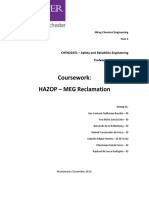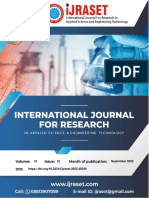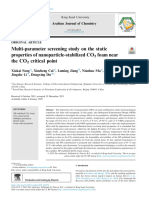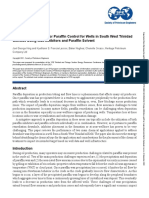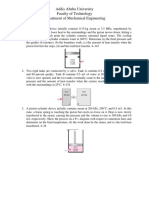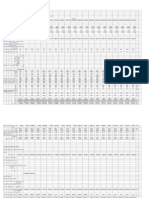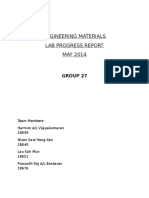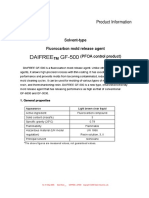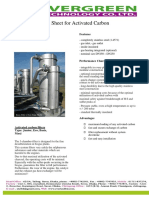Professional Documents
Culture Documents
Chemical Approach To Control Hydrate in Offshore Gas Production Facilities
Chemical Approach To Control Hydrate in Offshore Gas Production Facilities
Original Title
Copyright
Available Formats
Share this document
Did you find this document useful?
Is this content inappropriate?
Report this DocumentCopyright:
Available Formats
Chemical Approach To Control Hydrate in Offshore Gas Production Facilities
Chemical Approach To Control Hydrate in Offshore Gas Production Facilities
Copyright:
Available Formats
Volume 9, Issue 4, April – 2024 International Journal of Innovative Science and Research Technology
ISSN No:-2456-2165 https://doi.org/10.38124/ijisrt/IJISRT24APR1423
Chemical Approach to Control Hydrate in Offshore
Gas Production Facilities
Kate Odafe Idolor1 Oluwaseun Francis Owolabi2
1
Madonna University, Nigeria Gateway ICT Polytechnic, Saapade, Nigeria
2
Abstract:- Hydrate formation presents a significant of offshore platforms. The economic ramifications are
operational challenge in offshore oil and gas production, equally severe, with potential losses amounting to millions
primarily due to the potential formation of hydrate plugs of dollars per day due to interrupted production [5].
which obstruct fluid flow, thereby posing serious flow Moreover, traditional methods to manage hydrate formation,
assurance risks. Additionally, these solid, crystalline, ice- such as thermal and mechanical removal, are not only costly
like structures, composed of low molecular weight gases but also pose significant safety risks and environmental
(such as methane, ethane, and propane) encapsulated in concerns [6-8].
hydrogen-bonded water cages, can aggregate into larger
masses capable of damaging or rupturing pipelines. Such Recent advancements in simulation technologies, such
formations typically occur under the high-pressure and as the Prosper software, have revolutionized hydrate
low-temperature conditions prevalent in subsea flowlines management by enabling precise predictions of hydrate
and cold-weather operations. This study employs the formation conditions and optimizing the use of chemical
Prosper simulation software to model these complex inhibitors like Methanol, Monoethylene Glycol (MEG), and
thermodynamic and hydrodynamic conditions and to Triethylene Glycol (TEG) [9-12]. These inhibitors
predict the effective dosages of chemical inhibitors effectively shift the hydrate equilibrium, thus safeguarding
required to prevent hydrate formation. Specifically, our operational conditions from falling within the hydrate
simulations suggest optimal dosages of 35% wt. formation envelope.
methanol (MeOH) and 45% wt. monoethylene glycol
(MEG) for gas stream 1, and 22% wt. MeOH and 33% Significance of the Study
wt. MEG for gas stream 2. Based on these findings, we This study's significance is anchored in its potential to
advocate the use of Prosper simulation software as a enhance the safety, efficiency, and economic viability of gas
predictive tool for the strategic administration of production operations, particularly in offshore settings. By
hydrate inhibitors in offshore gas production facilities. integrating advanced simulation tools with empirical
This research contributes to the ongoing development of research, this work aims to develop robust chemical
chemical strategies for hydrate management, providing a methodologies for hydrate control, thus minimizing the
basis for improved safety and efficiency in hydrocarbon operational disruptions and hazards associated with hydrate
extraction processes. formations.
Keywords:- Gas Hydrates, Pipeline Corrosion, Hydrate The utilization of chemical inhibitors based on
Management, PVT Analysis, Flow Assurance. simulation-guided strategies represents a critical
advancement in the field. This approach not only helps in
I. INTRODUCTION preempting the formation of hydrates but also contributes to
the broader industry goal of maintaining uninterrupted flow
The formation and management of gas hydrates in the assurance. Flow assurance is crucial in ensuring that
natural gas industry present formidable challenges, traceable hydrocarbons are transported efficiently from the reservoir
to the pioneering work of Hammerschmidt in 1934 [1]. to the point of sale without blockages, thereby optimizing
These hydrate compounds, primarily consisting of gases like production and minimizing downtime.
methane, ethane, propane, isobutene, and carbon dioxide
trapped within a crystalline water structure, manifest under Furthermore, this research aligns with environmental
specific conditions of high pressure and low temperature sustainability goals by reducing the frequency and intensity
commonly encountered in subsea gas pipelines and of interventions required to manage hydrate formations,
processing facilities. Unlike ice, these hydrates have a lower such as the use of pigs or the application of heat. Each of
density and form at temperatures significantly above the these traditional methods carries a carbon footprint and
freezing point of water, behaving as a solid solution where potential ecological impacts, which can be mitigated
gas acts as the solute within a solvent cage of water through the proactive chemical management of hydrates.
molecules without chemical bonding [2-4]
The outcomes of this study are expected to offer dual
The operational challenges imposed by hydrates are benefits: enhancing operational efficiency and reducing
multifold, ranging from the formation of plugs that obstruct environmental impacts in offshore gas production. The
pipeline flow to structural damages threatening the integrity strategies developed herein could serve as a benchmark for
IJISRT24APR1423 www.ijisrt.com 995
Volume 9, Issue 4, April – 2024 International Journal of Innovative Science and Research Technology
ISSN No:-2456-2165 https://doi.org/10.38124/ijisrt/IJISRT24APR1423
the industry, promoting safer and more sustainable practices Full Composition: Yes
across global operations. Allow Lumping: No
Reference Temperature: 60°F
Reference Pressure: 0 psig
Phase detection Method: Advanced
Path to surface – Separator Use Separator Train
Calculation Method:
First stage: 200 psig and 80°F
Second stage: 0 psig and 60°F
Target GOR method: Use Separator fluids
PVT Data Input
For the simulation, PVT (Pressure, Volume,
Temperature) data is a critical component in assessing the
physical properties and behavior of the gas streams under
Fig 1 Effects of Hydrate Plug on Subsea Pipelines. A. Large various operational conditions. In this study, the PVT data
Gas Hydrate Plug Formed in a Subsea Hydrocarbon Pipeline was entered into the Prosper simulation software by
[1]. B. Corrosion in Subsea Pipelines [2]. accessing a predefined sample directory (Figure 2). This
directory provided baseline data which was then tailored
II. METHODOLOGY according to the specific characteristics of the gas streams
being analyzed, such as whether the gas was predominantly
Collection of Well Data wet or dry. Adjustments to the PVT data included
The study requires precise well data to manage hydrate modifications based on the gas composition, as well as
formation effectively in offshore gas production facilities, variations in temperature, pressure, and the boiling point
using data from two distinct sources for different gas differential. These changes are essential to accurately model
streams. Data for Gas Stream 1 were sourced from Shell the gas stream's behavior in the pipeline and predict hydrate
Nigeria Limited at the Obigbo gas plants. This data set formation conditions effectively. By fine-tuning the PVT
included operational temperatures, pipeline pressures, and settings to reflect the actual conditions of the gas streams,
the mole percentage composition of the gas. These the simulation can provide more precise and reliable
parameters are critical for assessing the risk of hydrate outputs.
formation and are used to model accurate predictions with
Prosper simulation software [13-15]. For Gas Stream 2, data
were obtained from Nalco Energy Services, encompassing
similar operational parameters such as temperature,
pressure, and detailed gas composition. This information is
crucial for predicting potential hydrate formation under
varying conditions [4].
Software for Hydrate Simulation
To predict the hydrate forming temperature and
pressure of a gas stream, the Prosper Simulation software
was utilized [16]. The process begins with launching
Prosper from the options menu, which allows for the
selection and setup of the fluid description type. The method
involves configuring the software to accurately represent the
fluid dynamics and chemical properties of the gas stream
being analyzed. This setup is crucial for ensuring that the
simulations reflect real-world conditions and provide
reliable data on hydrate formation risks under various
operational scenarios.
Table 1 Fluid Description Asset-up and iPROSPER
Software Equation of State Model
Fluid description – Type: Retrograde Condensate
Fluid description – Method: Equation Of State
Hydrates: Enable Warning
Calculation type – Model: Enthalpy Balance
EOS Model: Peng Robinson
Optimization Mode: Medium Fig 2 PVT Data of Dry Gas Stream Compisition 1 used in
Optimize Repeat Calculation: Yes Prosper Software
IJISRT24APR1423 www.ijisrt.com 996
Volume 9, Issue 4, April – 2024 International Journal of Innovative Science and Research Technology
ISSN No:-2456-2165 https://doi.org/10.38124/ijisrt/IJISRT24APR1423
III. RESULTS AND DISCUSSION
Impact of Inhibitor Concentration on Hydrate Formation
Conditions
We generated series of hydrate equilibrium curves,
delineating the predicted hydrate formation temperatures
and pressures for varying concentrations of chemical
inhibitors—specifically methanol and glycol—in Gas
Stream 1. These concentrations ranged from 0% (indicating
no inhibition) to increments of 10%, culminating at 45%.
The resulting data were visually represented across multiple
figures (Figures 4 and Figure 5), illustrating the
progressive shifts in hydrate formation conditions as the
concentration of inhibitors increased.
A detailed analysis focused particularly on the
conditions with 35% and 45% inhibitor concentrations.
These scenarios were graphically superimposed onto the
curve representing 0% inhibition (as displayed in Figure 4),
to highlight the significant shift in the hydrate formation
region. The comparative visualization clearly demonstrated
that the presence of chemical inhibitors effectively alters the
thermodynamic landscape of hydrate formation.
Specifically, with increasing concentrations of methanol and
glycol, the hydrate formation region is displaced to lower
Fig 3 PVT Data of Dry Gas Stream Compisition 2 used in temperatures and higher pressures, thereby reducing the risk
Prosper Software of hydrate formation under typical operational conditions.
This shift is indicative of the inhibitors' efficacy in
Hydrate Curve Generation and Analysis modifying the gas stream's thermodynamic environment,
In the PVT analysis phase within Prosper, a hydrate making it less conducive to hydrate formation. The results
curve was generated to visually represent the potential for underscore the importance of selecting appropriate inhibitor
hydrate formation under various conditions. This curve was dosages to optimize flow assurance while mitigating the
then stored within the Prosper file for further reference and risks associated with hydrate blockages in pipeline systems
analysis. During the simulation process, Prosper actively as also pointed out by Bavoh et al [14].
monitored the operating conditions—specifically pressure
and temperature—to determine if they fell within the
hydrate formation danger zone. The temperature range
employed for the analysis spanned from 33°F to 80°F, with
the simulation adjusting the temperature at each of the 10
incremental steps. This methodical variation allowed for a
detailed examination of how temperature fluctuations
influence hydrate stability within the specified range. The
resulting hydrate curve is visualized in the output, providing
a clear graphical representation of the conditions under
which hydrates are likely to form. This visual tool is crucial
for identifying critical thresholds and planning appropriate
operational strategies to avoid hydrate-related
complications.
Validation with Historical Data
We validated the simulation model against historical
data is crucial for ensuring its accuracy and reliability. This
step involves comparing the hydrate formation predictions
made by the Prosper simulation with actual instances of
hydrate occurrence documented during past operations. By
doing so, discrepancies can be identified and the model can
be calibrated to better reflect real-world conditions. This Fig 4 Hydrate Equilibrium Curves Delineating the Predicted
validation process enhances the confidence in the simulation Hydrate Formation Temperatures and Pressures for Varying
outputs, making them more actionable for operational Concentrations of Methyl Ethly Glycol (MEG) Chemical
planning and risk management. Inhibitor for Gas Stream 1
IJISRT24APR1423 www.ijisrt.com 997
Volume 9, Issue 4, April – 2024 International Journal of Innovative Science and Research Technology
ISSN No:-2456-2165 https://doi.org/10.38124/ijisrt/IJISRT24APR1423
Hydrate Management Through Inhibitor Modeling in
Prosper Software.
The Prosper simulation software was employed to
assess hydrate formation under specific operational
conditions for gas stream 1, defined by a pressure of 1500
psi and a temperature of 40°F. At this high pressure, the
hydrate equilibrium temperature without inhibitors was
predicted to be 70°F, placing the system within the hydrate
formation region. Initial modeling efforts using varying
concentrations of inhibitors—10% to 30% of methanol and
10% to 45% of MEG (monoethylene glycol)—were
conducted. However, these concentrations proved
insufficient, as indicated by the results displayed in Figure 5
for methanol and Figures 4for MEG, which showed that the
system remained within the hydrate-prone conditions.
To safely operate outside the hydrate formation region,
higher concentrations of inhibitors were needed. Injecting
35% wt. of methanol shifted the hydrate curve significantly
to the left (Figure 5), aligning the operating conditions to
the right of the hydrate equilibrium curve, thus moving out
of the hydrate forming region. The new hydrate equilibrium
temperature at 1500 psi was adjusted to 37°F, comfortably Fig 6 Hydrate Equilibrium Curves with and without
below the operating temperature. Similarly, injecting 45% Chemical Inhibitors for Gas Stream 1
wt. of MEG shifted the hydrate equilibrium to a new low of
40°F, ensuring operational safety. The same simulation strategy was applied to gas
stream 2 under identical operating conditions of 1500 psi
and 40°F, which also initially placed the system within the
hydrate formation region. Modeling with lower inhibitor
concentrations of 0%, 10%, and 30% methanol and 10% and
20% MEG (Figure 7) did not achieve the desired shift in
hydrate formation conditions. Ultimately, a 30%
concentration of MEG and 30% methanol (Figure 7) were
required to effectively move the hydrate formation
conditions outside of the critical region.
Fig 5 Hydrate Equilibrium Curves Delineating the Predicted
Hydrate Formation Temperatures and Pressures for Varying
Concentrations of Methanol Chemical Inhibitor for
Gas Stream 1
Fig 7 Hydrate Equilibrium Curves Delineating the Predicted
Hydrate Formation Temperatures and Pressures for Varying
Concentrations of MEG (Upper Panel) and Methanol
Chemical (Lower Panel) Inhibitor for Gas Stream 2
IJISRT24APR1423 www.ijisrt.com 998
Volume 9, Issue 4, April – 2024 International Journal of Innovative Science and Research Technology
ISSN No:-2456-2165 https://doi.org/10.38124/ijisrt/IJISRT24APR1423
This enhanced modeling approach demonstrates the wonderful contribution to the success of this research. We
importance of accurately determining and applying also wish to thank the staff and management of Shell
sufficient inhibitor concentrations to ensure that the Nigeria Limited and Nalco service Company for their
operational conditions in gas pipelines are maintained safely wonderful contribution towards the success of this research.
outside the hydrate formation thresholds. Our appreciation goes to Eng. Mrs. Ahamefule for the
critical analysis and constructive criticism.
IV. CONCLUSION
REFERENCES
This study has thoroughly evaluated the efficacy of
different hydrate inhibitors in offshore gas processing [1]. Hammerschmidt, E. G. Formation of Gas Hydrates in
facilities using Prosper simulation software. Monoethylene Natural Gas Transmission Lines. Ind. Eng. Chem.
glycol (MEG) emerged as the most effective inhibitor when 1934, 26(8), 851−855.
compared to methanol and NaCl, owing to several [2]. Nashed, O.; Sabil, K. M.; Lal, B.; Ismail, L.; Jaafar,
significant advantages. Firstly, MEG can be regenerated and A. J. Study of 1-(2-Hydroxyethyle)3-
reused, which contrasts sharply with methanol that lacks this Methylimidazolium Halide as Thermodynamic
capability. This feature of MEG not only aligns with Inhibitors. Appl. Mech. Mater. 2014, 625, 337−340.
sustainable practices but also renders it economically [3]. Pavlenko, A. M.; Koshlak, H. Intensification of Gas
advantageous despite its higher initial cost. Furthermore, Hydrate Formation Processes by Renewal of
MEG poses lower health, safety, and environmental risks, Interfacial Area between Phases. Energies 2021, 14,
making it the preferred choice in the Exploration and 5912.
Production (E&P) industry where safety is paramount. [4]. Chen, J.; Zeng, Y.; Liu, C.; Kang, M.; Chen, G.;
Deng, B.; Zeng, F. Methane Hydrate Dissociation
The analysis determined that the optimal dosages of from Anti-Agglomerants Containing Oil Dominated
inhibitors for effective hydrate control are 35% methanol Dispersed Systems. Fuel 2021, 294, 120561.
and 45% MEG for Gas Stream 1, and for Gas Stream 2, the [5]. Ul Haq, I.; Qasim, A.; Lal, B.; Zaini, D. B.; Foo, K.
dosages are 30% methanol and 30% MEG. These findings S.; Mubashir, M.; Khoo, K. S.; Vo, D. V. N.; Leroy,
underscore the necessity of selecting appropriate inhibitor E.; Show, P. L. Ionic Liquids for the Inhibition of Gas
concentrations to balance efficacy and economic Hydrates. A Review. Environ. Chem. Lett. 2022, 20,
considerations in hydrate management. 2165.
[6]. Song, G.; Li, Y.; Wang, W.; Jiang, K.; Shi, Z.; Yao, S.
RECOMMENDATIONS Hydrate Formation in Oil-Water Systems:
Investigations of the Influences of Water Cut and
Our study recommends the implementation of Gas Anti-Agglomerant. Chin. J. Chem. Eng. 2020, 28(2),
Sweetening Processes. In facilities where acid gases like 369−377.
H2S and CO2 are present, gas sweetening processes should [7]. Robinson, D. B.; Ng, H. J. Hydrate Formation and
be implemented. These gases contribute to the potential for Inhibition in Gas or Gas Condensate Streams. J. Can.
hydrate formation; therefore, removing them from the gas Pet. Technol. 1986, 25(4), 26−30.
stream significantly reduces this risk. Our study also [8]. Johal, K. S. Flow Assurance Technology Options For
emphasizes continuous monitoring of production parameters Deepwater & Long Distance Oil & Gas Transport.
is crucial. Real-time data acquisition and analysis can help Offshore Mediterranean Conference and Exhibition,
in predicting and preventing conditions conducive to hydrate March 28, 2007; p OMC-2007-071.
formation, thus ensuring uninterrupted gas flow and [9]. Bavoh, C. B.; Lal, B.; Osei, H.; Sabil, K. M.;
operational efficiency. Mukhtar, H. A Review on the Role of Amino Acids in
Gas Hydrate Inhibition, CO2 Capture and
To further mitigate the risk of hydrate formation, Sequestration, and Natural Gas Storage. J. Nat. Gas
dehydration of natural gas is recommended. Removing Sci. Eng. 2019, 64, 52.
moisture from the gas stream effectively lowers the [10]. Lv, Y. N.; Jia, M. L.; Chen, J.; Sun, C. Y.; Gong, J.;
probability of hydrate formation, enhancing the reliability of Chen, G. J.; Liu, B.; Ren, N.; Guo, S. Di; Li, Q. P.
pipeline operations. While kinetic inhibitors and anti- Self-Preservation Effect for Hydrate Dissociation in
agglomerates offer potential benefits in managing hydrates, Water+ Diesel Oil Dispersion Systems. Energy Fuels
their limitations must be thoroughly evaluated to ensure they 2015, 29(9), 5563−5572.
are feasible for production scenarios. This includes [11]. Koh, C. A.; Sloan, E. D.; Sum, A. K.; Wu, D. T.
considerations of cost, environmental impact, and their Fundamentals and Applications of Gas Hydrates.
integration into existing treatment systems. Annu. Rev. Chem. Biomol. Eng. 2011, 2, 237−257.
[12]. Zerpa, L. E.; Aman, Z. M.; Joshi, S.; Rao, I.; Sloan,
ACKNOWLEDGMENT E. D.; Koh, C.; Sum, A. Predicting Hydrate
Blockages in Oil, Gas and Water-Dominated
The Authors acknowledge the staff and management of Systems. Paper presented at the Offshore Technology
Federal University of petroleum resources, Effurun, Warri Conference; Houston, Texas, USA, April 2012.
and also to the staff and management of Federal University DOI:10.4043/23490-MS.
of Science and technology Owerri, Imo state for their
IJISRT24APR1423 www.ijisrt.com 999
Volume 9, Issue 4, April – 2024 International Journal of Innovative Science and Research Technology
ISSN No:-2456-2165 https://doi.org/10.38124/ijisrt/IJISRT24APR1423
[13]. Farhang, F.; Nguyen, A. V.; Hampton, M. A.
Influence of Sodium Halides on the Kinetics of CO2
Hydrate Formation. Energy Fuels 2014, 28(2),
1220−1229.
[14]. Bavoh, C. B.; Lal, B.; Osei, H.; Sabil, K. M.;
Mukhtar, H. A Review on the Role of Amino Acids in
Gas Hydrate Inhibition, CO2 Capture and
Sequestration, and Natural Gas Storage. J. Nat. Gas
Sci. Eng. 2019, 64, 52−71.
[15]. Wang, Y.; Fan, S.; Lang, X. Reviews of Gas Hydrate
Inhibitors in Gas-Dominant Pipelines and
Application of Kinetic Hydrate Inhibitors in China.
Chin. J. Chem. Eng. 2019, 27(9), 2118−2132.
IJISRT24APR1423 www.ijisrt.com 1000
You might also like
- 3M Tapes and AdhesivesDocument48 pages3M Tapes and AdhesivesArshadNo ratings yet
- Terms of ReferenceDocument5 pagesTerms of ReferenceSetemi 'sherlock' ObatokiNo ratings yet
- HAZOP STUDY Report (Kutch Chemical Industries Limited)Document82 pagesHAZOP STUDY Report (Kutch Chemical Industries Limited)kanakarao173% (11)
- Safety HAZOP CourseworkDocument31 pagesSafety HAZOP CourseworkMaximiano Ferraz0% (1)
- Corrosion InhibitorDocument16 pagesCorrosion InhibitorNata 1986100% (1)
- Application of Enzymes in TextilesDocument7 pagesApplication of Enzymes in TextilesSENTHIL KUMARNo ratings yet
- 6.4.3. Torsional and Flexural-Torsional Buckling Under Thrust and End MomentsDocument5 pages6.4.3. Torsional and Flexural-Torsional Buckling Under Thrust and End MomentspraveennagarajanNo ratings yet
- Astm g1Document8 pagesAstm g1ahmad.zaki84No ratings yet
- Modeling, Control, and Optimization of Natural Gas Processing PlantsFrom EverandModeling, Control, and Optimization of Natural Gas Processing PlantsRating: 5 out of 5 stars5/5 (1)
- PC 1 FlowAssurance PDFDocument21 pagesPC 1 FlowAssurance PDFAlvaro VelardeNo ratings yet
- ACC WE DB3250 Swimming Pools Technical Services STD 1 0 Aug 11 PDFDocument33 pagesACC WE DB3250 Swimming Pools Technical Services STD 1 0 Aug 11 PDFJoão Pereira100% (1)
- Theory and Technology of Multiscale Dispersed Particle Gel for In-Depth Profile ControlFrom EverandTheory and Technology of Multiscale Dispersed Particle Gel for In-Depth Profile ControlNo ratings yet
- Solving The Pipe-Flow Calculation Maze: Thermal Mass FlowmetersDocument68 pagesSolving The Pipe-Flow Calculation Maze: Thermal Mass FlowmetersOlaleye Akeem Kehinde100% (4)
- Gas Flare Design Debottlenecking Using Pinch AnalysisDocument25 pagesGas Flare Design Debottlenecking Using Pinch AnalysisRicardo BecNo ratings yet
- Mineral Resources SeminarDocument21 pagesMineral Resources Seminarsini100% (2)
- Do We Have New Solutions To The Old Problem of Gas Hydrates?Document6 pagesDo We Have New Solutions To The Old Problem of Gas Hydrates?govindNo ratings yet
- Asia-Pacific J Chem Eng - 2020 - Buabbas - A Parametric Simulation On The Effect of The Rejected Brine Temperature On TheDocument14 pagesAsia-Pacific J Chem Eng - 2020 - Buabbas - A Parametric Simulation On The Effect of The Rejected Brine Temperature On TheRohitThakranNo ratings yet
- High-Throughput Testing of Kinetic Hydrate InhibitorsDocument7 pagesHigh-Throughput Testing of Kinetic Hydrate InhibitorsLOLA PATRICIA MORALES DE LA CUBANo ratings yet
- The Effect of Acidic Gases and Thermodynamic Inhibitors On The Hydrates Phase Boundary of Synthetic Malaysia Natural GasDocument10 pagesThe Effect of Acidic Gases and Thermodynamic Inhibitors On The Hydrates Phase Boundary of Synthetic Malaysia Natural GasLOLA PATRICIA MORALES DE LA CUBANo ratings yet
- E3sconf ght2020 01003 PDFDocument12 pagesE3sconf ght2020 01003 PDFSidharth SinghNo ratings yet
- Spe 207797 MsDocument8 pagesSpe 207797 MsJesus D. Arrieta GarridoNo ratings yet
- A Prevention and Control Method For Natural Gas Hydrate in Pipe StringsDocument11 pagesA Prevention and Control Method For Natural Gas Hydrate in Pipe StringsTrung Dinh DucNo ratings yet
- Technologies Optimize Flow AssuranceDocument7 pagesTechnologies Optimize Flow AssuranceManus AgereNo ratings yet
- 2003 JordanDocument16 pages2003 JordanjohanpenuelaNo ratings yet
- Calbry-Muzyka Et Al-2020-Frontiers in Energy ResearchDocument14 pagesCalbry-Muzyka Et Al-2020-Frontiers in Energy ResearchEduardo TamargoNo ratings yet
- Irjet V6i11234Document4 pagesIrjet V6i11234EMRULLAH DESTEGÜLNo ratings yet
- Hydrogen Sources DiagramDocument9 pagesHydrogen Sources DiagramFSBollNo ratings yet
- Paper THERMODYNAMICASSESS - OFMED 01 PDFDocument20 pagesPaper THERMODYNAMICASSESS - OFMED 01 PDFHhhh GehrhhNo ratings yet
- MECCOCT18-12629: Managing Corrosion in NGL Plant Through Establishment of IOWDocument8 pagesMECCOCT18-12629: Managing Corrosion in NGL Plant Through Establishment of IOWOwais MalikNo ratings yet
- Processes 10 02233Document14 pagesProcesses 10 02233ReneeNo ratings yet
- Development and Simulation of Natural Gas Refining Mechanism Based On Exergy StudyDocument11 pagesDevelopment and Simulation of Natural Gas Refining Mechanism Based On Exergy StudyIJRASETPublicationsNo ratings yet
- SPE 107335 Hydraflow: Avoiding Gas Hydrate Problems: HYDRAFLOW Technology Could Offer Significant Benefits OverDocument10 pagesSPE 107335 Hydraflow: Avoiding Gas Hydrate Problems: HYDRAFLOW Technology Could Offer Significant Benefits OverJackyNo ratings yet
- AIChE Journal - 2023 - Casas Orozco - Techno Economic Analysis of Dynamic End To End Optimal Pharmaceutical CampaignDocument18 pagesAIChE Journal - 2023 - Casas Orozco - Techno Economic Analysis of Dynamic End To End Optimal Pharmaceutical CampaigntrialaccountformeNo ratings yet
- Comprehensive Thickening Analysis StrategyDocument8 pagesComprehensive Thickening Analysis Strategyalejin2014No ratings yet
- Martins, 2023. On The Green Hydrogen Production Through Gasification Processes A Techno-Economic ApproachDocument12 pagesMartins, 2023. On The Green Hydrogen Production Through Gasification Processes A Techno-Economic ApproachvitorazjrNo ratings yet
- Marine and Petroleum GeologyDocument55 pagesMarine and Petroleum GeologyIrving MagañaNo ratings yet
- Predicting Corrosion in PipelinesDocument11 pagesPredicting Corrosion in PipelinesAderobaki GbengaNo ratings yet
- Gas Hydrates: Its Present and Future Scenario Emphasizing On Technological and Environmental and Economical ChallengesDocument12 pagesGas Hydrates: Its Present and Future Scenario Emphasizing On Technological and Environmental and Economical ChallengesharshiniNo ratings yet
- Chimical UnitDocument13 pagesChimical Unitxtrooz abiNo ratings yet
- Retrofitting An Isopropanol Process Based On Reactive Distillation and Propylene-Propane SeparationDocument10 pagesRetrofitting An Isopropanol Process Based On Reactive Distillation and Propylene-Propane SeparationHadis ShojaeiNo ratings yet
- IPTC-22235-MS Foams To Control Slugging Issues in Pipeline - From Lab To SimulationDocument9 pagesIPTC-22235-MS Foams To Control Slugging Issues in Pipeline - From Lab To SimulationLuky HendraningratNo ratings yet
- MPD - High Performance and Reliability For MPD Control System Ensured by Extensive TestingDocument17 pagesMPD - High Performance and Reliability For MPD Control System Ensured by Extensive TestingGiang Nguyen NinhNo ratings yet
- Economic Study of Offshore Marginal Oil Field Development: January 2020Document12 pagesEconomic Study of Offshore Marginal Oil Field Development: January 2020Indra BRNo ratings yet
- Membrane Technology: Real World Studies Utilizing For SDWA ComplianceDocument2 pagesMembrane Technology: Real World Studies Utilizing For SDWA ComplianceIndra Budhi KurniawanNo ratings yet
- Mitigation of BTEX Emission From Gas Dehydration Unit by ApplicationDocument15 pagesMitigation of BTEX Emission From Gas Dehydration Unit by ApplicationarispriyatmonoNo ratings yet
- SPE-172435-MS Comparative Analysis of Permanent Downhole Gauges and Their ApplicationsDocument11 pagesSPE-172435-MS Comparative Analysis of Permanent Downhole Gauges and Their ApplicationsSabrina PeñaNo ratings yet
- 4174 10399 1 PBDocument15 pages4174 10399 1 PBtoniNo ratings yet
- Coatings 08 00402Document22 pagesCoatings 08 00402capcanNo ratings yet
- Chemicals and Manufacturing CompendiumDocument176 pagesChemicals and Manufacturing CompendiumTomas Barrientos BrunaNo ratings yet
- Design PI Controller For TankDocument11 pagesDesign PI Controller For TankabhinavparkheNo ratings yet
- Processes: Adsorption As A Process For Produced Water Treatment: A ReviewDocument22 pagesProcesses: Adsorption As A Process For Produced Water Treatment: A ReviewZakiah Darajat NurfajrinNo ratings yet
- Hydrate Plug MechanismsDocument10 pagesHydrate Plug Mechanismsrjehanathan7098No ratings yet
- Journal Pre-ProofDocument52 pagesJournal Pre-ProofBriand VallejoNo ratings yet
- The Recovery of Waste Heat From The Absorber Vent Gases of A CO 2 Capture Unit by Using Membrane Distillation Technology For Freshwater ProductionDocument12 pagesThe Recovery of Waste Heat From The Absorber Vent Gases of A CO 2 Capture Unit by Using Membrane Distillation Technology For Freshwater ProductionSaifullah ZadranNo ratings yet
- Raikova Et Al., 2016. Towards - An - Aviation - Fuel - Through - The - HydrothermalDocument24 pagesRaikova Et Al., 2016. Towards - An - Aviation - Fuel - Through - The - HydrothermalMelquiades ArizaNo ratings yet
- Jurnal Arab AzuraDocument13 pagesJurnal Arab AzuraAzura nadyaNo ratings yet
- Pro 4Document3 pagesPro 4Hande KorkmazNo ratings yet
- 1 s2.0 S0255270122002148 MainDocument11 pages1 s2.0 S0255270122002148 MainIndra PranataNo ratings yet
- International Journal of Greenhouse Gas Control: Liyuan Deng, May-Britt Ha GGDocument9 pagesInternational Journal of Greenhouse Gas Control: Liyuan Deng, May-Britt Ha GGMiguel RibeiroNo ratings yet
- Catalyst Deactivation1Document8 pagesCatalyst Deactivation1Hussain AliNo ratings yet
- Application of Metering Process in Oil and Gas Production in Niger Delta FieldsDocument7 pagesApplication of Metering Process in Oil and Gas Production in Niger Delta FieldsNikhilRPandeyNo ratings yet
- Analyses and Filed Applications of Gas Hydrate Inhibitors 2015 CikkDocument9 pagesAnalyses and Filed Applications of Gas Hydrate Inhibitors 2015 CikkSamNo ratings yet
- 04.new Liquid Overflow Handling System To Prevent Process Tank FiresDocument14 pages04.new Liquid Overflow Handling System To Prevent Process Tank FiresHerry SuhartomoNo ratings yet
- Spe 200966 MsDocument12 pagesSpe 200966 MsJesus D. Arrieta GarridoNo ratings yet
- Pchemeng 2019 106710Document26 pagesPchemeng 2019 106710RohitThakranNo ratings yet
- Assessment of Integrated Poultry Manure and Synthetic Fertilizer Effects on Maize (Zea mays) Growth and Soil Properties: A Study from Bayero University, KanoDocument15 pagesAssessment of Integrated Poultry Manure and Synthetic Fertilizer Effects on Maize (Zea mays) Growth and Soil Properties: A Study from Bayero University, KanoInternational Journal of Innovative Science and Research Technology100% (1)
- Seasonal Variation and Distribution Patterns of Endophytic Community in Withania SomniferaDocument7 pagesSeasonal Variation and Distribution Patterns of Endophytic Community in Withania SomniferaInternational Journal of Innovative Science and Research TechnologyNo ratings yet
- Utilizing Chicken Eggshells and Waste Glass Powder as Cement Fillers for Environmental StabilityDocument6 pagesUtilizing Chicken Eggshells and Waste Glass Powder as Cement Fillers for Environmental StabilityInternational Journal of Innovative Science and Research TechnologyNo ratings yet
- Personal Capabilities of The Non-Teaching Personnel and Client SatisfactionDocument8 pagesPersonal Capabilities of The Non-Teaching Personnel and Client SatisfactionInternational Journal of Innovative Science and Research TechnologyNo ratings yet
- Transforming Challenges to Victories: An Inquiry on Transformational Leadership of School Leaders in the Public Elementary SchoolsDocument54 pagesTransforming Challenges to Victories: An Inquiry on Transformational Leadership of School Leaders in the Public Elementary SchoolsInternational Journal of Innovative Science and Research TechnologyNo ratings yet
- The Influence of Continuance Commitment on Job Satisfaction of Barangay Health Workers in Malaybalay City, BukidnonDocument14 pagesThe Influence of Continuance Commitment on Job Satisfaction of Barangay Health Workers in Malaybalay City, BukidnonInternational Journal of Innovative Science and Research TechnologyNo ratings yet
- Intelligent Clinical Documentation: Harnessing Generative AI For Patient-Centric Clinical Note GenerationDocument15 pagesIntelligent Clinical Documentation: Harnessing Generative AI For Patient-Centric Clinical Note GenerationInternational Journal of Innovative Science and Research TechnologyNo ratings yet
- Exploring The Potential Advantages of Traditional Therapies in Autoimmune Blistering Illnesses: A Comprehensive Review and Analysis, ResearchDocument12 pagesExploring The Potential Advantages of Traditional Therapies in Autoimmune Blistering Illnesses: A Comprehensive Review and Analysis, ResearchInternational Journal of Innovative Science and Research TechnologyNo ratings yet
- Meta Land: Redefining Virtual Communities Through Centralized Governance, Inclusivity and InnovationDocument5 pagesMeta Land: Redefining Virtual Communities Through Centralized Governance, Inclusivity and InnovationInternational Journal of Innovative Science and Research TechnologyNo ratings yet
- Solar Based Multilevel Inverter F o R BLDC Motor DriveDocument8 pagesSolar Based Multilevel Inverter F o R BLDC Motor DriveInternational Journal of Innovative Science and Research TechnologyNo ratings yet
- Skin Disease Detection and Remedial SystemDocument7 pagesSkin Disease Detection and Remedial SystemInternational Journal of Innovative Science and Research TechnologyNo ratings yet
- Design and Development of Multi-Featured Medical StretcherDocument4 pagesDesign and Development of Multi-Featured Medical StretcherInternational Journal of Innovative Science and Research TechnologyNo ratings yet
- EmoConnect: Nurturing Trust and Relationship Bonds in Alzheimer's ConversationsDocument3 pagesEmoConnect: Nurturing Trust and Relationship Bonds in Alzheimer's ConversationsInternational Journal of Innovative Science and Research TechnologyNo ratings yet
- Unlocking Sentiments: Enhancing IOCL Petrol Pump ExperiencesDocument8 pagesUnlocking Sentiments: Enhancing IOCL Petrol Pump ExperiencesInternational Journal of Innovative Science and Research TechnologyNo ratings yet
- Smart and Secure Home With ChatbotDocument9 pagesSmart and Secure Home With ChatbotInternational Journal of Innovative Science and Research TechnologyNo ratings yet
- Preparation and Identification of Magnetic Iron Nanoparticle Based On A Natural Hydrogel and Its Performance in Targeted Drug DeliveryDocument17 pagesPreparation and Identification of Magnetic Iron Nanoparticle Based On A Natural Hydrogel and Its Performance in Targeted Drug DeliveryInternational Journal of Innovative Science and Research TechnologyNo ratings yet
- Development of Smart Ground Fault Location Model For Radial Distribution SystemDocument14 pagesDevelopment of Smart Ground Fault Location Model For Radial Distribution SystemInternational Journal of Innovative Science and Research TechnologyNo ratings yet
- Fall Detection and Boundary Detection in Care HomesDocument7 pagesFall Detection and Boundary Detection in Care HomesInternational Journal of Innovative Science and Research TechnologyNo ratings yet
- Application of Plant Growth Promoting Rhizobacteria On Vegetative Growth in Chili Plants (Capsicum Frutescens L.)Document7 pagesApplication of Plant Growth Promoting Rhizobacteria On Vegetative Growth in Chili Plants (Capsicum Frutescens L.)International Journal of Innovative Science and Research TechnologyNo ratings yet
- Exploring The Post-Annealing Influence On Stannous Oxide Thin Films Via Chemical Bath Deposition Technique: Unveiling Structural, Optical, and Electrical DynamicsDocument7 pagesExploring The Post-Annealing Influence On Stannous Oxide Thin Films Via Chemical Bath Deposition Technique: Unveiling Structural, Optical, and Electrical DynamicsInternational Journal of Innovative Science and Research TechnologyNo ratings yet
- Reading Intervention Through "Brigada Sa Pagbasa": Viewpoint of Primary Grade TeachersDocument3 pagesReading Intervention Through "Brigada Sa Pagbasa": Viewpoint of Primary Grade TeachersInternational Journal of Innovative Science and Research TechnologyNo ratings yet
- Firm Size As A Mediator Between Inventory Management Andperformance of Nigerian CompaniesDocument8 pagesFirm Size As A Mediator Between Inventory Management Andperformance of Nigerian CompaniesInternational Journal of Innovative Science and Research TechnologyNo ratings yet
- Application of Game Theory in Solving Urban Water Challenges in Ibadan-North Local Government Area, Oyo State, NigeriaDocument9 pagesApplication of Game Theory in Solving Urban Water Challenges in Ibadan-North Local Government Area, Oyo State, NigeriaInternational Journal of Innovative Science and Research TechnologyNo ratings yet
- Global Warming Reduction Proposal AssessmentDocument6 pagesGlobal Warming Reduction Proposal AssessmentInternational Journal of Innovative Science and Research TechnologyNo ratings yet
- On The Development of A Threat Driven Model For Campus NetworkDocument14 pagesOn The Development of A Threat Driven Model For Campus NetworkInternational Journal of Innovative Science and Research TechnologyNo ratings yet
- Detection of Phishing WebsitesDocument6 pagesDetection of Phishing WebsitesInternational Journal of Innovative Science and Research TechnologyNo ratings yet
- A Study To Assess The Knowledge Regarding Teratogens Among The Husbands of Antenatal Mother Visiting Obstetrics and Gynecology OPD of Sharda Hospital, Greater Noida, UpDocument5 pagesA Study To Assess The Knowledge Regarding Teratogens Among The Husbands of Antenatal Mother Visiting Obstetrics and Gynecology OPD of Sharda Hospital, Greater Noida, UpInternational Journal of Innovative Science and Research TechnologyNo ratings yet
- PHREEQ C Modelling Tool Application To Determine The Effect of Anions On Speciation of Selected Metals in Water Systems Within Kajiado North Constituency in KenyaDocument71 pagesPHREEQ C Modelling Tool Application To Determine The Effect of Anions On Speciation of Selected Metals in Water Systems Within Kajiado North Constituency in KenyaInternational Journal of Innovative Science and Research TechnologyNo ratings yet
- Mandibular Mass Revealing Vesicular Thyroid Carcinoma A Case ReportDocument5 pagesMandibular Mass Revealing Vesicular Thyroid Carcinoma A Case ReportInternational Journal of Innovative Science and Research TechnologyNo ratings yet
- Esophageal Melanoma - A Rare NeoplasmDocument3 pagesEsophageal Melanoma - A Rare NeoplasmInternational Journal of Innovative Science and Research TechnologyNo ratings yet
- AssignDocument2 pagesAssignHabtamu Tkubet EbuyNo ratings yet
- Rheology:: Non-Newtonian Systems: Plastic FlowDocument8 pagesRheology:: Non-Newtonian Systems: Plastic FlowHemant DhunganaNo ratings yet
- Electrolysis of Aqeous SolutionDocument6 pagesElectrolysis of Aqeous Solutionanon_383714618No ratings yet
- Basic Principles of PhysicsDocument5 pagesBasic Principles of PhysicsChristmaeJusselMalabrigoCantalejoNo ratings yet
- Unit 3 May 2019 Q3 QDocument5 pagesUnit 3 May 2019 Q3 Qnlm malNo ratings yet
- Features and Benefits: Technical Data SheetDocument6 pagesFeatures and Benefits: Technical Data SheetTaufiq SatrioNo ratings yet
- Thermal PollutionDocument18 pagesThermal PollutionIastraNo ratings yet
- Atomic OrbitalsDocument6 pagesAtomic OrbitalsKailin BrophyNo ratings yet
- Some Aspects of Laser Surface Cladding in The Turbine IndustryDocument8 pagesSome Aspects of Laser Surface Cladding in The Turbine IndustrysenthilNo ratings yet
- BHU-M.Sc. Question Paper 2011Document25 pagesBHU-M.Sc. Question Paper 2011SAikat AdhikaryNo ratings yet
- GRN Report Wash Plant 21-22....Document384 pagesGRN Report Wash Plant 21-22....nasir ahmedNo ratings yet
- To Find Refractive Index of Different Liquids Using Hollow PrismDocument9 pagesTo Find Refractive Index of Different Liquids Using Hollow PrismsanjanaNo ratings yet
- Collins MR Physics and Hardware ReviewDocument62 pagesCollins MR Physics and Hardware ReviewMilena RakinNo ratings yet
- Fisa Tehnica Mapeflex Pu20Document4 pagesFisa Tehnica Mapeflex Pu20nitsannsNo ratings yet
- Capsules and It's Technology: An Overview: ArticleDocument12 pagesCapsules and It's Technology: An Overview: ArticleVinny PetonenganNo ratings yet
- Compaction and CompressionDocument6 pagesCompaction and CompressionHaroon Rahim100% (1)
- Adolf Martens and His Contributions To Materials EngineeringDocument30 pagesAdolf Martens and His Contributions To Materials EngineeringRolando Nuñez MonrroyNo ratings yet
- 9) Design Col. and Rafter 002Document4 pages9) Design Col. and Rafter 002Er navneet jassiNo ratings yet
- Engineering Materials Lab ReportDocument18 pagesEngineering Materials Lab ReportAhmad Fakhrie ShahNo ratings yet
- Reacting Mixtures and CombustionDocument54 pagesReacting Mixtures and CombustionnunuNo ratings yet
- Daifree GF500 - eDocument3 pagesDaifree GF500 - eRonak VaghaniNo ratings yet
- Activated Carbon Technical Data SheetDocument2 pagesActivated Carbon Technical Data SheetMd SuruzzamanNo ratings yet
- EarthSci Worksheet1 M1 BelarminoDocument1 pageEarthSci Worksheet1 M1 BelarminoAyesha Faye BelarminoNo ratings yet
- Safety Data Sheet: Opt I KL een-WF™Document9 pagesSafety Data Sheet: Opt I KL een-WF™Richard ReedNo ratings yet



